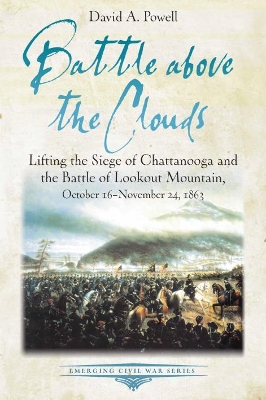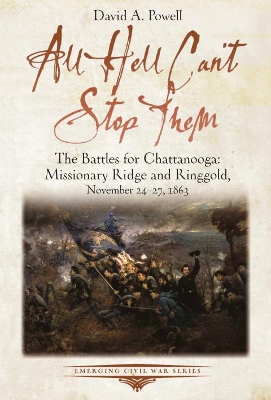Emerging Civil War
2 total works
In October 1863, the Union Army of the Cumberland was besieged in Chattanooga, all but surrounded by familiar opponents: The Confederate Army of Tennessee. The Federals were surviving by the narrowest of margins, thanks only to a trickle of supplies painstakingly hauled over the sketchiest of mountain roads. Soon even those quarter-rations would not suffice. Disaster was in the offing.
Yet those Confederates, once jubilant at having routed the Federals at Chickamauga and driven them back into the apparent trap of Chattanooga’s trenches, found their own circumstances increasingly difficult to bear. In the immediate aftermath of their victory, the South rejoiced; the Confederacy’s own disasters of the previous summer—Vicksburg and Gettysburg—were seemingly reversed. Then came stalemate in front of those same trenches. The Confederates held the high ground, Lookout Mountain and Missionary Ridge, but they could not completely seal off Chattanooga from the north.
The Union responded. Reinforcements were on the way. A new man arrived to take command: Ulysses S. Grant. Confederate General Braxton Bragg, unwilling to launch a frontal attack on Chattanooga’s defenses, sought victory elsewhere, diverting troops to East Tennessee.
Battle above the Clouds by David Powell recounts the first half of the campaign to lift the siege of Chattanooga, including the opening of the “cracker line,” the unusual night battle of Wauhatchie, and one of the most dramatic battles of the entire war: Lookout Mountain.
Yet those Confederates, once jubilant at having routed the Federals at Chickamauga and driven them back into the apparent trap of Chattanooga’s trenches, found their own circumstances increasingly difficult to bear. In the immediate aftermath of their victory, the South rejoiced; the Confederacy’s own disasters of the previous summer—Vicksburg and Gettysburg—were seemingly reversed. Then came stalemate in front of those same trenches. The Confederates held the high ground, Lookout Mountain and Missionary Ridge, but they could not completely seal off Chattanooga from the north.
The Union responded. Reinforcements were on the way. A new man arrived to take command: Ulysses S. Grant. Confederate General Braxton Bragg, unwilling to launch a frontal attack on Chattanooga’s defenses, sought victory elsewhere, diverting troops to East Tennessee.
Battle above the Clouds by David Powell recounts the first half of the campaign to lift the siege of Chattanooga, including the opening of the “cracker line,” the unusual night battle of Wauhatchie, and one of the most dramatic battles of the entire war: Lookout Mountain.
To many of the Federal soldiers watching the Stars and Stripes unfurl atop Lookout Mountain on the morning of November 25, 1863, it seemed that the battle to relieve Chattanooga was complete. The Union Army of the Cumberland was no longer trapped in the city, subsisting on short rations and awaiting rescue; instead, they were again on the attack.
Ulysses S. Grant did not share their certainty. For Grant, the job he had been sent to accomplish was only half-finished. Braxton Bragg’s Confederate Army of Tennessee still held Missionary Ridge, with other Rebels under James Longstreet threatening more Federals in Knoxville, Tennessee. Grant’s greatest fear was that the Rebels would slip away before he could deliver the final blows necessary to crush Bragg completely.
That blow landed on the afternoon of November 25. Each of Grant’s assembled forces—troops led by Union Generals William T. Sherman, George H. Thomas, and Joseph Hooker—all moved to the attack. Stubbornly, Bragg refused to retreat, and instead accepted battle. That decision would cost him dearly.
But everything did not go Grant’s way. Despite what Grant’s many admirers would later insist was his most successful, most carefully planned battle, Grant’s strategy failed him—as did his most trusted commander, Sherman. Victory instead charged straight up the seemingly impregnable slopes of Missionary Ridge’s western face, as the men of the much-maligned Army of the Cumberland swarmed up and over Bragg’s defenses in an irresistible blue tide.
Caught flat-footed by this impetuous charge, Grant could only watch nervously as the men started up . . .
All Hell Can’t Stop Them: The Battles for Chattanooga—Missionary Ridge and Ringgold, November 24-27, 1863—sequel to Battle Above the Clouds—details the dramatic final actions of the battles for Chattanooga: Missionary Ridge and the final Confederate rearguard action at Ringgold, where Patrick Cleburne held Grant’s Federals at bay and saved the Army of Tennessee from further disaster.
Ulysses S. Grant did not share their certainty. For Grant, the job he had been sent to accomplish was only half-finished. Braxton Bragg’s Confederate Army of Tennessee still held Missionary Ridge, with other Rebels under James Longstreet threatening more Federals in Knoxville, Tennessee. Grant’s greatest fear was that the Rebels would slip away before he could deliver the final blows necessary to crush Bragg completely.
That blow landed on the afternoon of November 25. Each of Grant’s assembled forces—troops led by Union Generals William T. Sherman, George H. Thomas, and Joseph Hooker—all moved to the attack. Stubbornly, Bragg refused to retreat, and instead accepted battle. That decision would cost him dearly.
But everything did not go Grant’s way. Despite what Grant’s many admirers would later insist was his most successful, most carefully planned battle, Grant’s strategy failed him—as did his most trusted commander, Sherman. Victory instead charged straight up the seemingly impregnable slopes of Missionary Ridge’s western face, as the men of the much-maligned Army of the Cumberland swarmed up and over Bragg’s defenses in an irresistible blue tide.
Caught flat-footed by this impetuous charge, Grant could only watch nervously as the men started up . . .
All Hell Can’t Stop Them: The Battles for Chattanooga—Missionary Ridge and Ringgold, November 24-27, 1863—sequel to Battle Above the Clouds—details the dramatic final actions of the battles for Chattanooga: Missionary Ridge and the final Confederate rearguard action at Ringgold, where Patrick Cleburne held Grant’s Federals at bay and saved the Army of Tennessee from further disaster.

